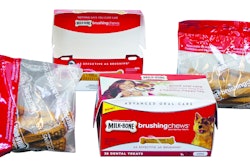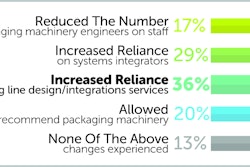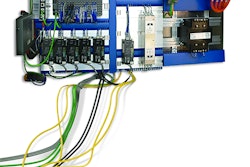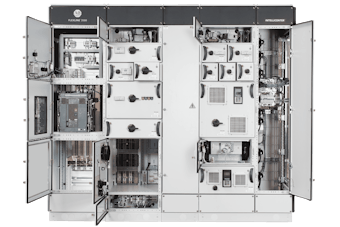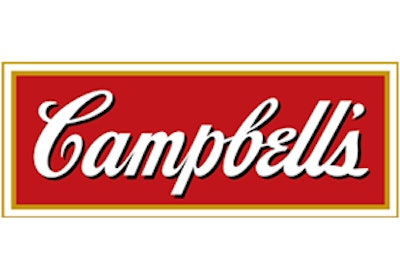
A long time proponent of advertising, the Camden, New Jersey-based food processor is as recognizable for its “Mmm, Mmm Good” slogan and iconic soup can as it is for the contents inside. Andy Warhol’s interpretation of the can during the pop art movement of the 1960s only pushed Campbell’s brand recognition to greater heights.
Perhaps longstanding brand awareness, and recognition of the vital role packaging plays, are some of the reasons Jim Prunesti, vice president/global engineering, has such a great partnership with his procurement group. A 30-year veteran of consumer packaged goods and food industries, with stops at Kraft Foods, Nabisco and L’Oreal, Prunesti now secures machinery for not only the soups, but also Campbell’s snack and health beverage divisions.
“We do it collaboratively,” he says. “We have a process matrix that we go through and evaluate the strengths and weaknesses of each proposal that we will get back. Then we will make a decision together. The engineering team is responsible for choosing the best technical solution that includes total cost of ownership (TCO) and the finance procurement team works hand in hand with us in working out the final commercial terms of the purchase.” Each collaboration begins with a requirements document containing both the financial and technical solutions. Prunesti, his team, and procurement then review with a common goal in mind. “They are co-owners with us on the total cost of ownership model,” he says. “The ongoing cost, performance, rebuild timing and costs, etc., is just as important as the capital price.”
TCO taking over
From his experience and interactions with peers in the food industry, he would likely advise machinery OEMs to embrace all things TCO. Other food processors big and small are embracing the TCO model, reinforcing Prunesti’s take that he faces the same challenges as his colleagues—and competitors.
“I think there is a trend in not just the food industry, but the whole CPG industry,” he says. “We have more common challenges than we have unique challenges, especially when you think about capital investment and what we are trying to deliver. It’s total cost of ownership and lowest cost solutions. It’s speed to market, asset performance, sanitary design, quick changeovers, flexibility, and capability. Can we adapt the equipment to do something different because that product lifecycle or that package format may change?” In addition to TCO and all its components, Prunesti sees the same focus on ergonomics, safety, and sanitary design. One place he turns for assistance with hammering out the specifics of these factors is PMMI’s OpX Leadership Network (formerly the Alliance for Innovation and Operational Excellence). “We participate pretty actively with that initiative,” he says. “We have a number of folks on my team that participate in their sanitary design standards, on TCO standards, on the factory acceptance testing standards, and things of that nature.”
He also appreciates OpX for its inclusive approach, something he felt the industry has lacked. In his opinion, OEMs and packaging developers too often were the only ones invited to the table, unintentionally leaving out packaging engineers.
“I started as a packaging equipment engineer,” he says. “OpX has provided packaging engineers a forum to allow us to have that interaction so that hopefully we can find a win-win solution. It’s not something different for the end user; it is also something the OEM sees value in. It gives us opportunities and lower costs because perhaps if we can develop standards, [OEMs] can build it one way versus having a Campbell way versus a Kraft way versus a Kellogg’s way versus a General Mills way. We are all kind of asking for the same thing. That would probably help the OEMs too.”
Making friends
Prunesti sees it as beneficial to all parties that partnerships between OEMs and their customers are handled like relationships, rather than business arrangements.
“I think it’s a win-win,” he says. “It’s an effort, but it’s pay-me-now or pay-me-later. If there is a blemish in the machine that isn’t caught at the factory acceptance test, I guarantee it will get caught down on the floor, and you are going to have an unhappy customer. You would have to spend more money to go fix that customer’s problem.”
While understanding each other’s point of view early and often is usually an asset, Prunesti admits being burned on occasion by OEMs who are looking for nothing more than a sale. Sometimes, the perception of a trusted partnership leads to irritation down the road with solutions developed collaboratively between Campbell’s and an OEM. “Here is a hot button for me and I don’t think it’s just me,” Prunesti says. “I have worked at a number of large multinationals and food companies in my career, and every time we come in the door with our standards, we end up getting into some interesting discussions in the form of debates about costs for customization.” Sometimes, he thinks those costs are warranted. But other times, he has experienced paying the extra for a custom machine or project, only to see that same custom technology at PACK EXPO as a standard for the OEM. Prunesti is aware of other large companies that insist on their standards essentially becoming proprietary, though Campbell’s doesn’t do this. The reasoning is sound in that the customer is being charged additionally for customization that in turn becomes standard on an OEM’s equipment line. Instead, he feels, there should be a little give and take on both sides. “While there are probably times they need to have some increased costs associated with our standards, I would challenge the OEMs to look at that and say, ‘how do we make sure that not every [tweak] is looked upon as custom?’,” he says. “There actually could be some that could be valuable equipment improvements that allow them to have a better offering to the broader marketplace.”
On the flip side of the coin, OEMs that offer more than they need to in terms of down the road performance, the aforementioned total cost of ownership, etc., can build incomparable loyalty.
“OEMs need to look at things like failure analysis,” Prunesti says, using it as an example of how OEMs can improve. “We are going to go buy a piece of machinery, a labeler, packer, a filler, a process system; and one thing we ask is ‘do we already have [something similar] operating in one of our plants already or something similar to it? If we do, how is it performing? Is it performing to our expectations and standards? Is there an opportunity for improvement?’”
If Campbell’s finds circumstances for improvement, they do a failure analysis to find ways it could work better. Prunesti asks OEMs if they do this and has found not all do it.
“That value is again built into the robustness of your equipment. If you built in robustness—when you avoid those failure modes—then when it is out in the field, you are going to have a happier customer,” he says. “You are not going to have to spend as much money going to fix problems later.
“And you become top of mind as the preferred supplier for that piece of equipment.”

